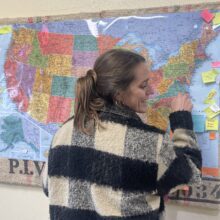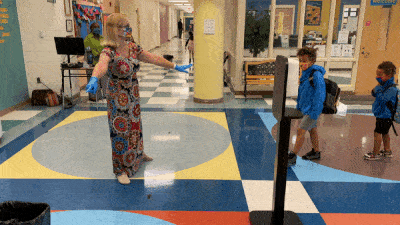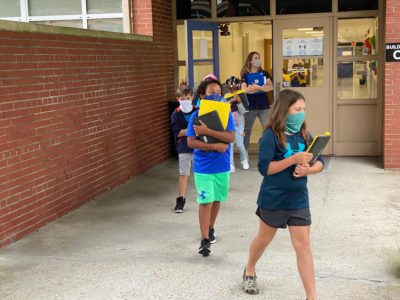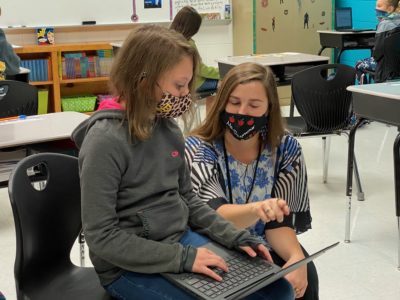On Aug. 17, the first day of school, Transylvania County Schools began operating under plan B, a hybrid model of in-person and online instruction. According to Bryan Abernethy, principal of Brevard High School, around 75% of the school’s students opted for some in-person instruction, while 25% chose the district-wide Online Learning Path.
Brevard High has been a one-to-one school for almost 10 years, which means every student has their own device. For the last five years, the school has utilized “virtual days,” or fully online instruction, when buses can’t pick up students due to inclement weather. This gave the district a small head start when the COVID-19 pandemic shut school buildings down in the spring.
Brevard High educators, along with many across the state and nation, are teaching in a whole new world. Teachers are reconstructing lesson plans, filming experiments, coding tests, and uploading and downloading everything; essentially having to entirely alter the way they would usually do their job.
We attended one day of in-person instruction and learned about the challenges and silver linings to this year’s educator experience. Come to class with EdNC.
7:45 a.m. — Arrival at Brevard High
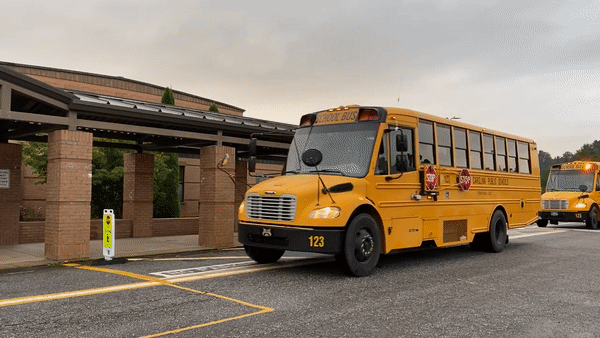
Buses roll in from altered routes, picking up half of the student body who opted for in-person instruction. Of the students who chose plan B, 50% come on Monday/Wednesday and the others come on Tuesday/Thursday. Some bus drivers are high-risk, so faculty members with their commercial drivers licenses are getting behind the wheel. Brevard High School’s assistant principal is driving a route in the morning and afternoon.
“It’s all hands on deck, whatever it takes to get them here safely.”
Bryan Abernethy, principal of Brevard High School
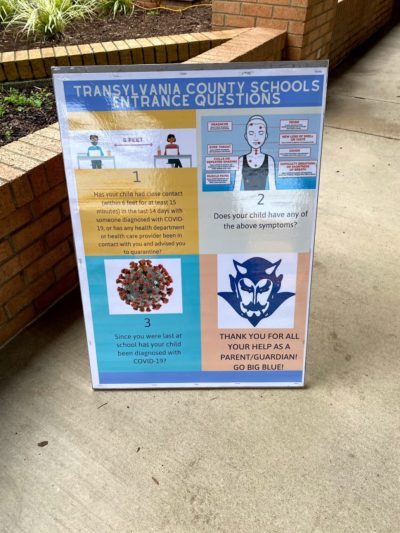
Entrance questions at Brevard High. Caroline Parker/EducationNC 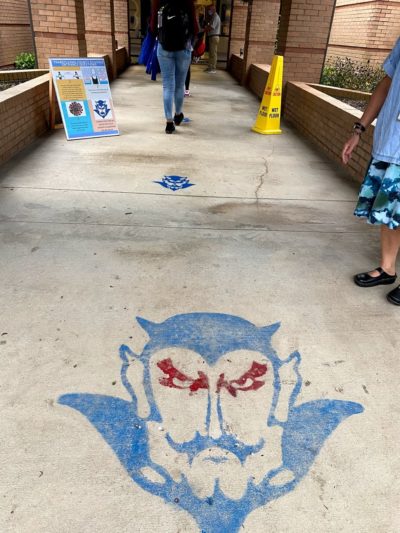
Socially distances temperature checks. Caroline Parker/EducationNC
After hopping off the bus, students head to get their temperature checked. They stand in line, 6 feet apart, on top of a spray painted blue devil, the school’s mascot. Teachers were outside to greet students and ask those important health questions: How are you feeling? Have you felt bad in the last 24 hours? Have you had a cough, fever, or headache? If the answer is no, their temperature is taken, and they head inside.
8:10 a.m. — First block: Mr. Tuckey’s physical science class
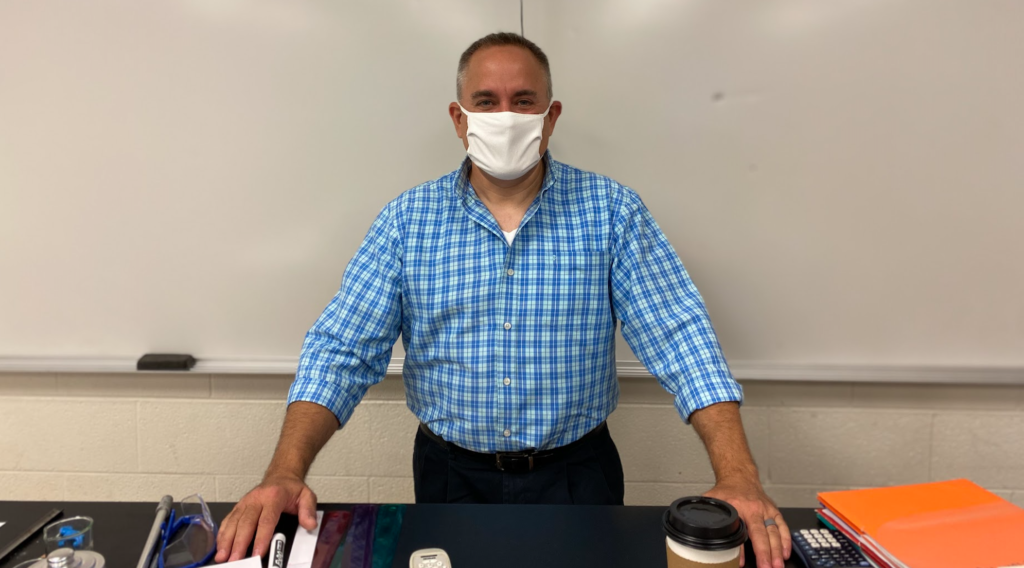
Matt Tuckey is a 25-year veteran educator and has been a science teacher for seven of those years at Brevard High School. He teaches virtually and in-person on the same day, flipping the lesson for the different type of instruction.
The biggest challenge he identified? Time. Creating lesson plans for this new model and organizing them so they can be accessible to his students can be a lot. He has to film videos and adapt his instruction to more of a narrative form for those students online who don’t catch him while he is teaching live.
For the first block, he’s had to alter his expectations for students during synchronous instruction. Some of his students have double-booked classes or have spotty internet access so they cannot check-in. We listened to him take attendance, go through special instructions for the day’s lessons, manage technical issues, and answer specific homework questions. The class then “leaves” to work on the days lesson.
Next door, Brevard High School’s TIME class is meeting in-person. We head through the lab to see how this 14-year-old inquiry-based program is working within a hybrid instruction model.
8:50 a.m. — First block: Ms. William’s TIME class

The focus of the TIME (Time Inquiry Matter Explore) class is research. Jennifer Williams, a 20-year science and math teacher at Brevard High, started this class because she wanted her students to learn how conduct in-depth scientific research on topics that interests them.
Take these two seniors, Isaiah Lefler and Graham Green. They applied to be in TIME 101, the prerequisite to TIME, when they were freshmen. Lefler and Green have stuck together through the years, and continue to go deeper in their project. They are trying to figure out how to turn urine into plant fertilizer.
Plan B’s hybrid model of instruction creates obstacles for this very hands-on class. Some partners attend school on opposite days. Lab time is cut in half for everyone. Competitions are canceled.
However, that is just another element the students must overcome in their research journey. Williams is always getting her students to ask more questions, and this is just another one to tackle.
“We want them to really see that there’s a reason to do this, and that it can be used to solve problems,” says Williams.
9:55 a.m. — Second block: Mr. McCann’s Pre-AP US History class
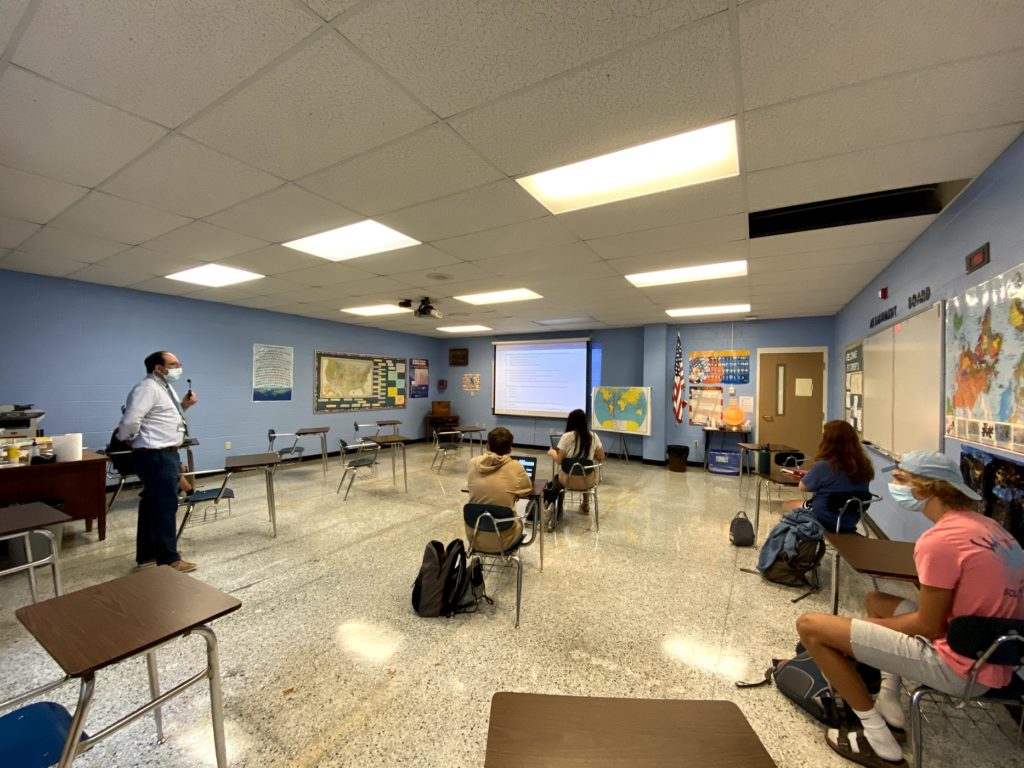
Mark McCann is a 25-year veteran educator, and 13 of those years have been spent in the Brevard High social studies hall. He walks around with a microphone, engaging students online as well as the four students joining in-person. He says other than the first semester of his teaching career, this may be the most challenging. Engaging students online has been difficult to muster. “It’s very lonely,” he says.
McCann understands the hesitation to speak up when students aren’t in the classroom. With connection issues, or a video delay, it can sometimes feel uncomfortable. When he has kids in class, they are more familiar with how to engage. For students that are coming to school in-person, he has them only two days a week, and there isn’t any time to waste.
“You got to hit it and go on. There’s not a lot of time for filler,” McCann says.
He teaches in-person and online everyday except for Fridays. He has had to outsource content delivery to students. This means he teaches what he can in class, creates outlines for all chapters, and then depends on the students to take notes and read on their own.
Analysis and discussion is what he focuses on in class. He understands that in the real world, people have resources at their finger tips, so for testing, he drills down on critical thinking skills.
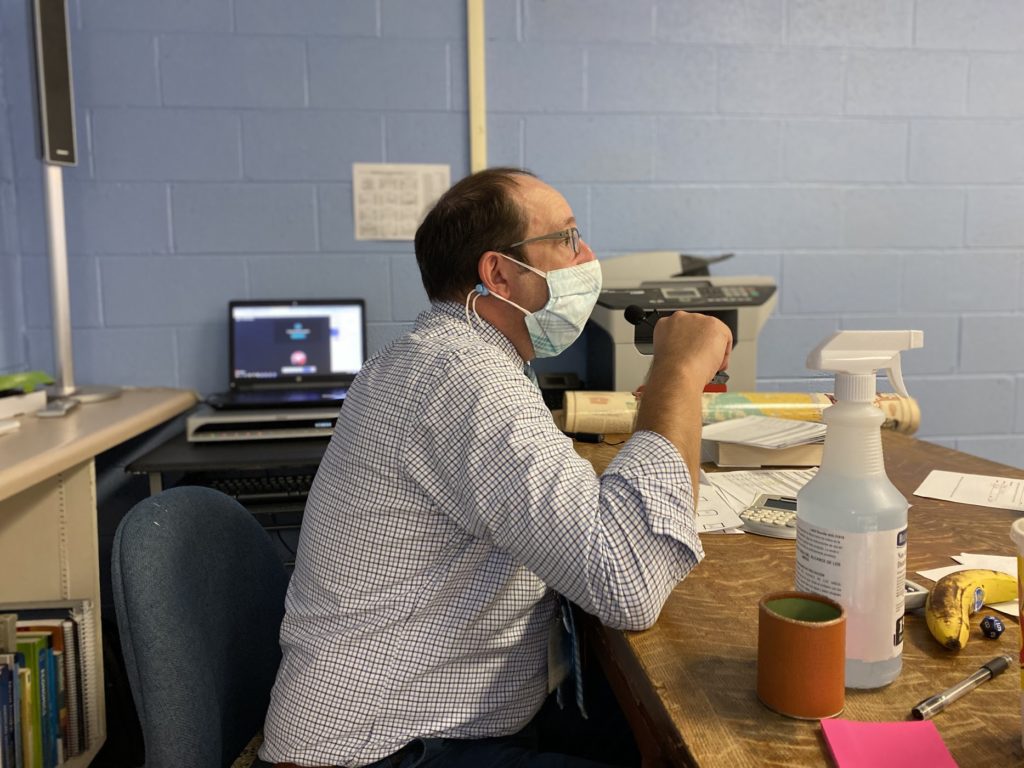
If anything, this year has re-emphasized the value of in-person learning for McCann.
“Even when they’re here, just two days a week, I feel that we’re getting a lot more accomplished. I feel more effective as a teacher when they’re in the classroom,” he explains.
“I’m glad that we’re here and I get to interact with kids. I was dreading another semester of kids off in the void.”
Mark MCCann, Brevard High School educator
Lunch — Meeting with Principal Bryan Abernethy
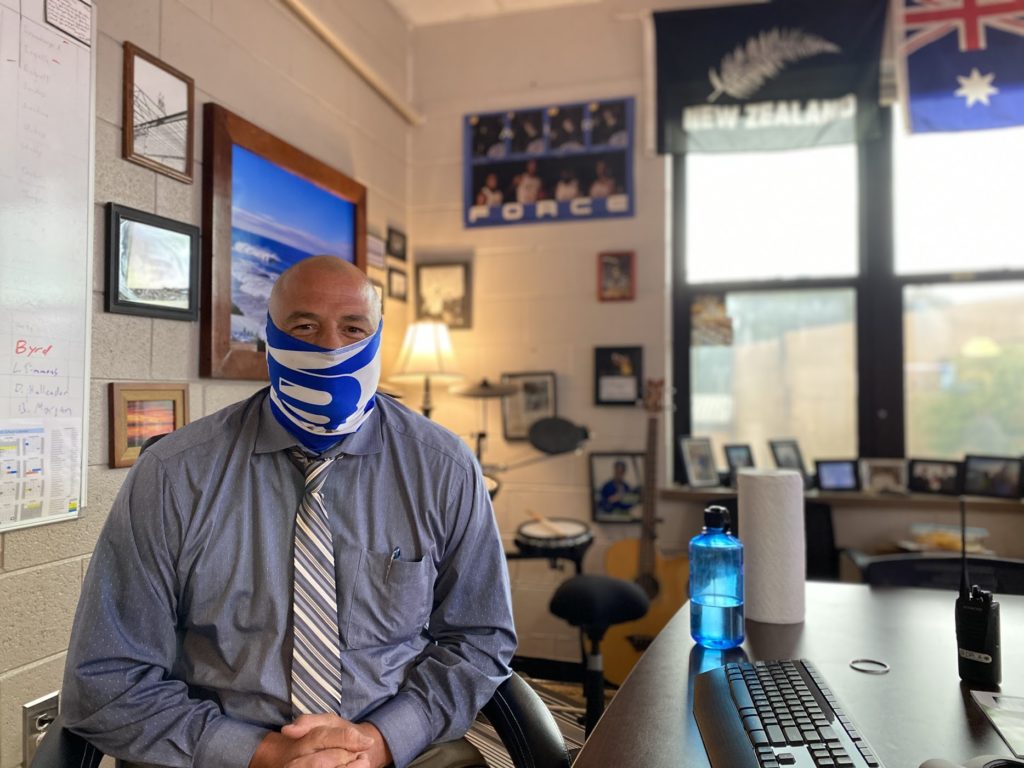
“It’s weird seeing the hallway so empty. Even [in] their transitions, you know, I miss the the hustle and bustle of it.”
Bryan Abernethy, principal of Brevard High School
What did Brevard High School do to encourage the school board to look at all angles of a potential plan B? Take them to class, Abernethy said.
Once the central office put together plan B, Brevard High mocked up classrooms and hallways for school board members to tour. On several occasions, board members traveled the hallways with directional arrows, kept socially distanced, and mimicked what student movement patterns would look like. They put themselves in the shoes of the students they serve.
Brevard High has also set up outdoor classrooms that teachers can use at their leisure. The mountain weather is a plus, as is their geographic isolation. Abernethy believes that was a factor in choosing plan B. With low case numbers, it felt that the benefits of being in school outweighed the risk, says Abernethy.
What is his biggest worry? “Let’s face it, there has to be more of a focus on students’ overall health right now. When that comes first, then learning can occur, you know what I mean?” said Abernethy.
School is a big factor in a child’s life, and if they can’t come in person, where are they instead? He is concerned about his students’ social and emotional wellbeing, and he worries if their basic needs are being met. Not having them in school to check-in with everyday and see their faces is a missing piece of the puzzle, he says. Abernethy is proud that his school is able to offer a safe plan B.
“I’m honored to work in a place that does put children first no matter what.”
Bryan Abernethy, principal of Brevard High School
12:01 p.m. — Third block: Mr. Stubbs’s civics and economics class
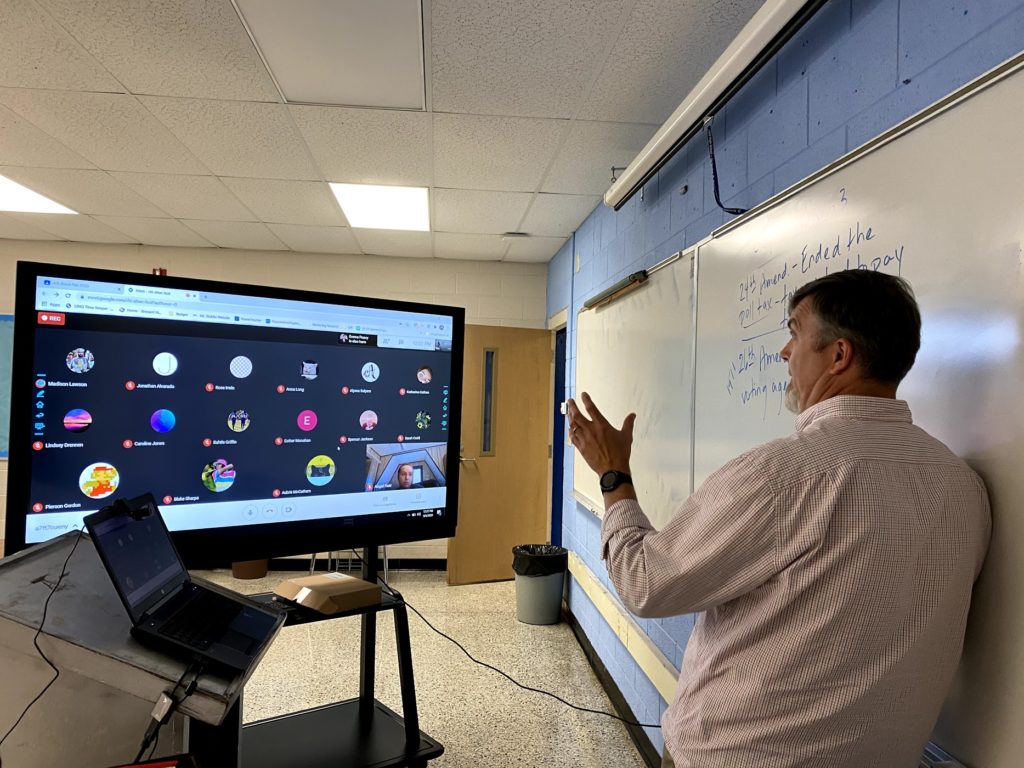
Richard Stubbs is in his ninth year of teaching. In this class, he teaches 21 students from two different schools online everyday except for Friday. Transylvania has two public high schools and an alternative school. Students from Rosman High can now take classes remotely if they are offered at Brevard.
After his experience of teaching fully remote in the spring, Stubbs knew he could operate better with a different tool. He grabbed the largest screen he could find and created his own version of a DAKboard. While plugged into this large, interactive touch screen for instruction, his camera faces him on the white board, and students have a direct view while he writes.
His class is learning about amendments right now. One of the frustrations he has with online instruction is the lack of feedback he receives. He can read a student’s body language when they are in class. They engage more when you can relate what they are learning to things happening in the real world, and its easier to do so in-person, Stubbs says. Engagement presents a constant challenge for everyone.
1:35 p.m. — Fourth block: Ms. Reinhart’s 11th grade honors English class
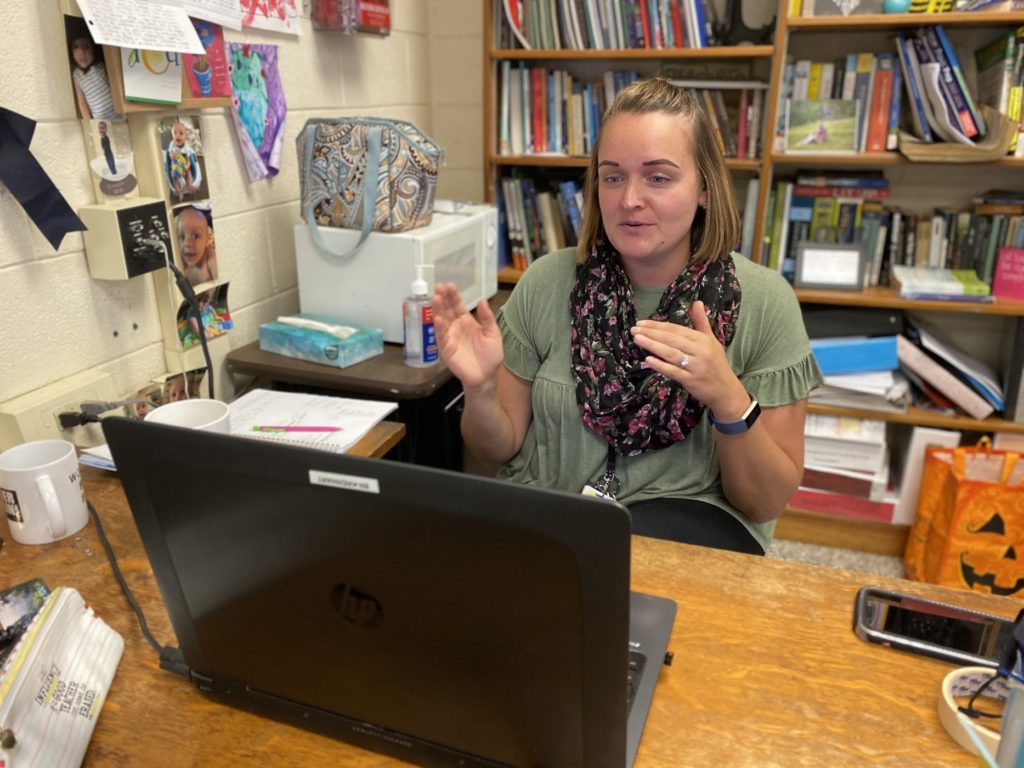
The last block of our day, we visited with 11-year educator Katie Reinhart. She is in front of her computer waiting for her fully online students to log on. Reinhart said in this hybrid model, it feels like she is teaching seven classes instead of three. Between the A and B schedule in-person, and those students who are fully remote, it’s a lot to balance.
She sets up office hours on Friday for students to touch base with her, and assigns independent work they can turn in for attendance. Some silver linings to this year? Small class sizes in-person means more individualized instruction. She is also really enjoying her fully online class and says that it actually feels the most normal, because they have class four days a week with the same structure.
Afterschool activities
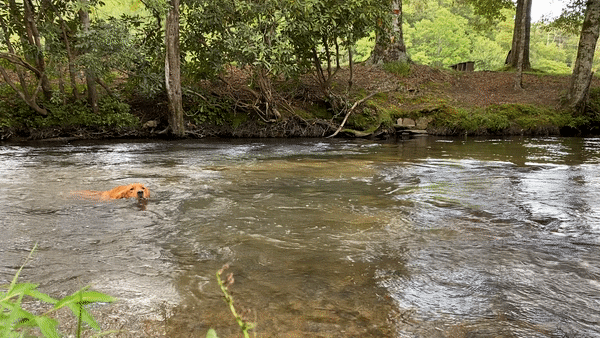
What do you do after school in Transylvania County during a pandemic? The same things you would do without a pandemic; sit outside, amongst a stream, and play fetch. One day of in-person instruction at Brevard High School left us with many thoughts, most important among them: educators are doing all they can to continue serving the students they love.
